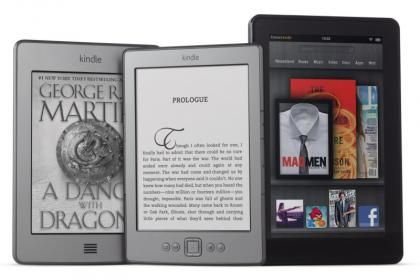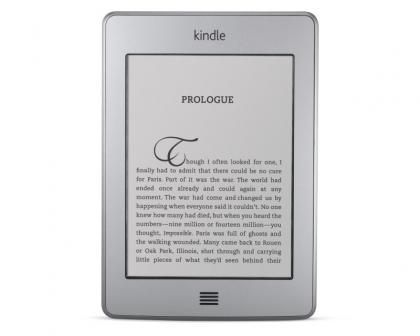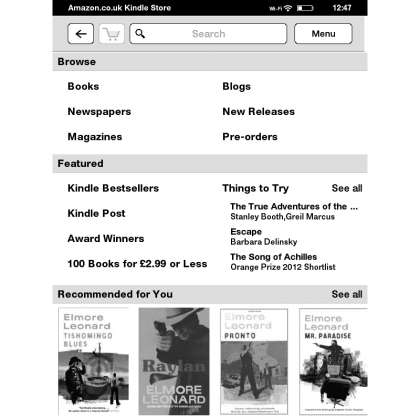After a long and unexplained delay the Kindle Touch is finally available on British shores, over six months after its US launch. While the current slimline Amazon Kindle stripped out all the less-used features from the now clunky-looking keyboard version; the new Kindle Touch brings back the vast majority of these in a more sleek-looking package.
It's undoubtedly a little heavier and a little chunkier than the basic Kindle. It's slightly larger in every dimension, measuring 172x120x10.1mm compared to 166x114x8.7mm. It's not a huge difference, but we found the smaller model fitted better in our inside jacket pocket. There's not much weight difference either on paper, with the Touch weighing in at 213g compared to 170g for the basic Kindle. It may not sound much, but the lighter Kindle is definitely more comfortable to hold for long periods unsupported.

Here you can see the size difference between the Kindle and Kindle Touch, alongside the still-awaited Kindle Fire tablet
For those who are used to the older Amazon Kindle 3 (now known as the Kindle Keyboard), the Kindle Touch is a little shorter, but almost as wide and a little chunkier, so there's great benefit in this department for those considering an upgrade.
A TOUCHING READ
The Kindle Touch uses the same 6in E Ink Pearl display as the other available Kindles, and for that matter pretty much every current eBook reader on the market. You get all the usual benefits of great contrast, a display you can read in any lighting conditions (except the dark), and a reasonable resolution for smaller fonts.
The big difference with the Kindle Touch is that Amazon has added a touch-screen capability to the screen. In fact it's a bit more complex than that, the screen itself is unchanged, as discussed above; instead, an optical sensor is mounted around the edges of the display, which detects where your finger lands on the screen. This is the same system used by other touch-enabled eBook readers such as the Kobo eReader Touch and Sony Reader PRS-T1 .

The Kindle looks better without all those buttons, but the colour scheme is still incredibly dull
In practice the touchscreen works well for reading, with Amazon opting for a tap-based page turn rather than requiring a swipe, Tapping on most of the screen turns the page, while a tap on the far left-hand side goes back a page and tapping the top of the screen brings up the menu bar. You can also swipe if you prefer, with right-to-left swipes going forward and left-to-right to go back.
The touchscreen makes little difference when just reading book, the buttons on the other Kindle models are well-placed, and the still relatively slow page turns are more of an issue for eBook readers than how your turn those pages. If, like us, you prefer reading books in landscape mode, though, then the touch controls adapt and are therefore better than buttons.
It comes into its own when you make use of the Kindle's other functions. Buying books is a breeze, as long as you know what you want; for book browsing we still prefer to use a PC browser, flicking between Amazon itself and review sites. Still, if you're caught out for something to read on holiday, the Kindle Touch will serve you far better than previous devices in this respect.
It's worth noting here, though, that the 3G version of the Kindle Touch costs a whopping £60 more than the basic Wi-Fi version. That's a big price hike for the pleasure of not finding a Wi-Fi hotspot. It seems that Amazon may have underestimated the costs that the 3G service incurred, as the price differential between such models is rising.

Buying books on the go is far easier using the new touchscreen interface
Coming back to the touchscreen, it certainly makes managing the books on your Kindle far easier, you can long press to bring up a menu with options such as deleting unwanted samples, bringing up the book description or viewing notes you've made. Speaking of which, if you do like to annotate books as you go, then the Kindle Touch is great, we found typing with the onscreen keyboard to be surprisingly accurate. It offers completed words as you type, but doesn't autocorrect misspelled words to the most likely of these options.
